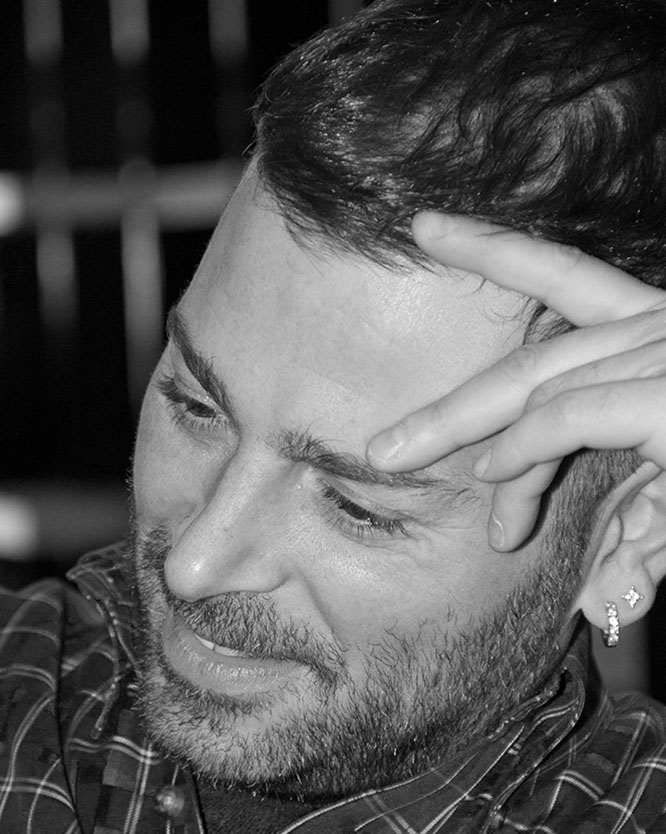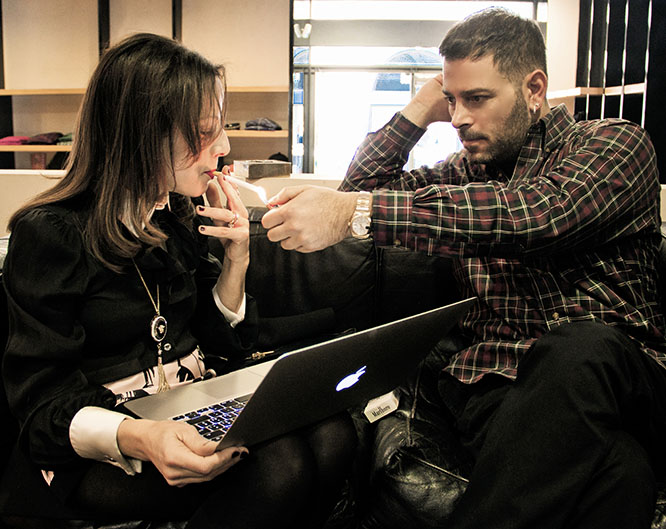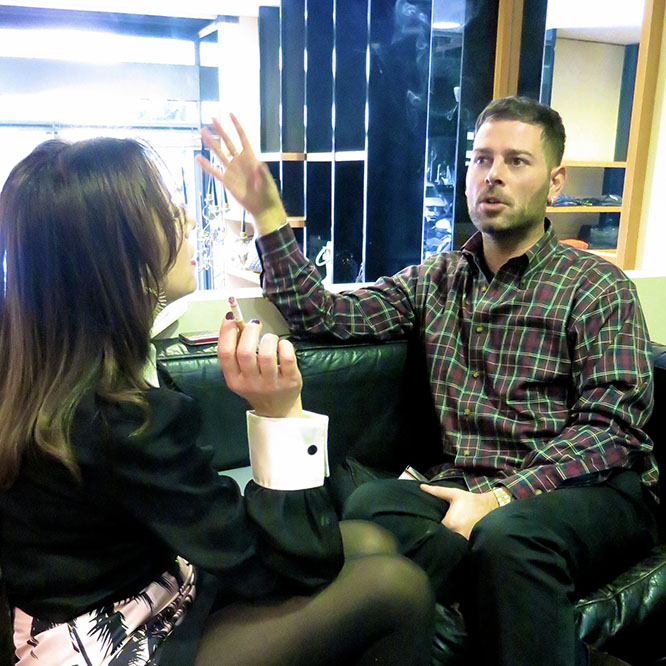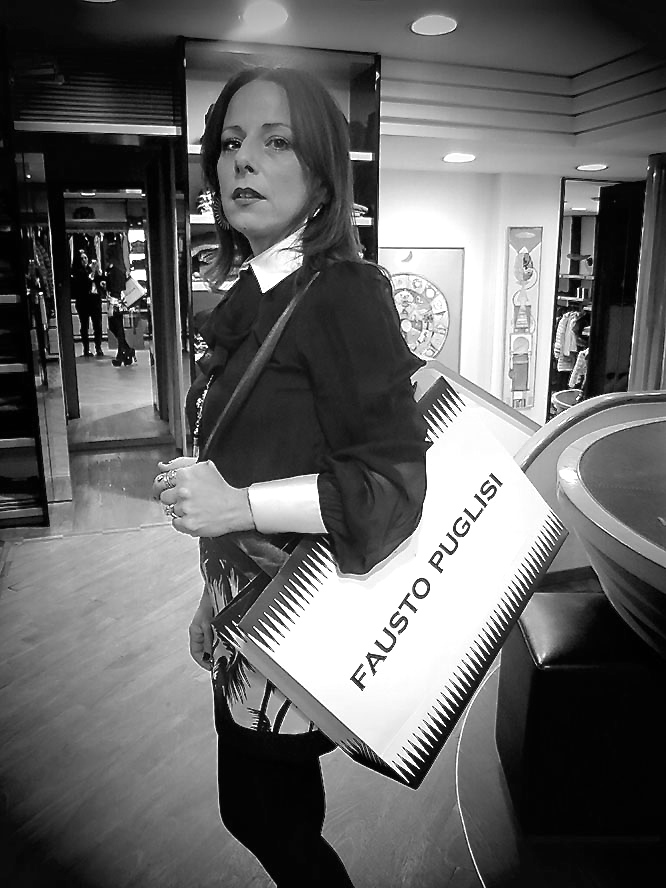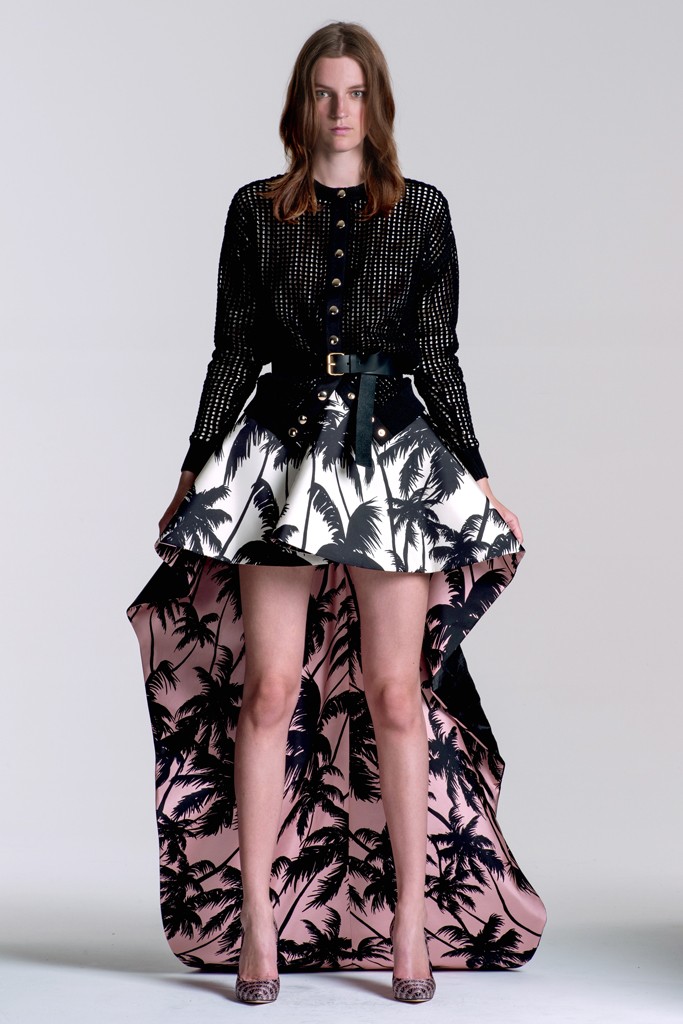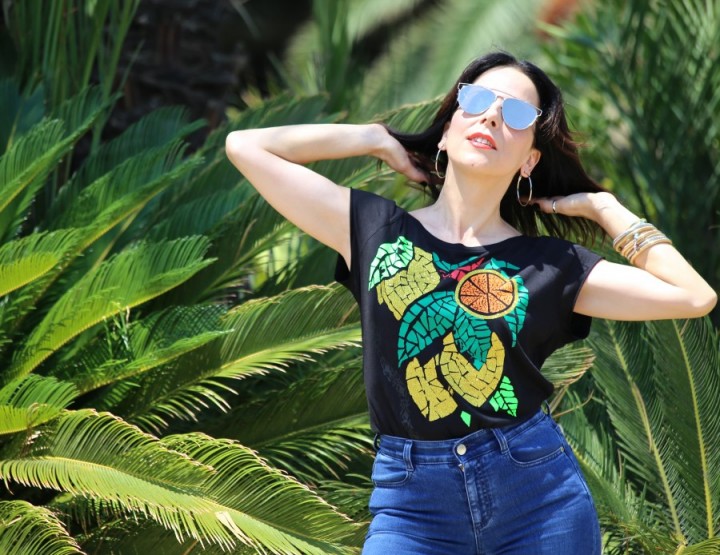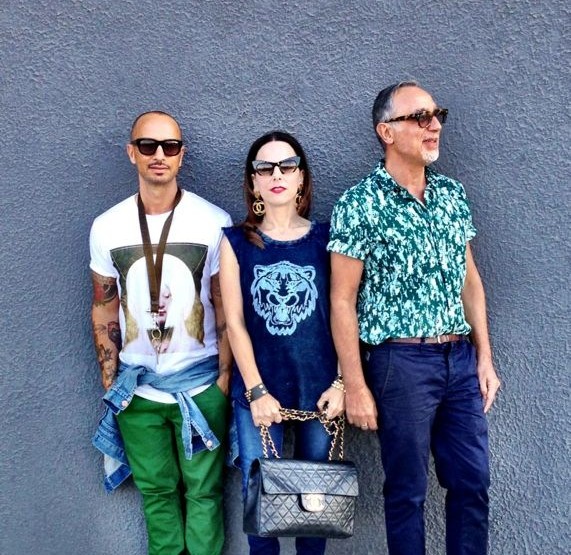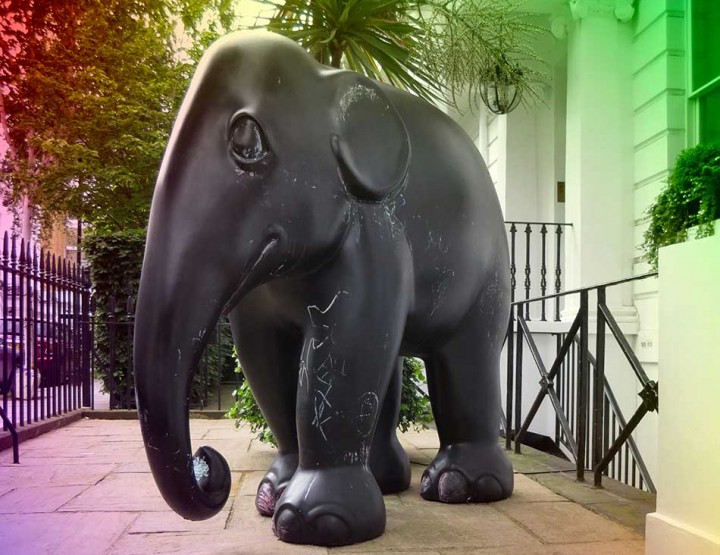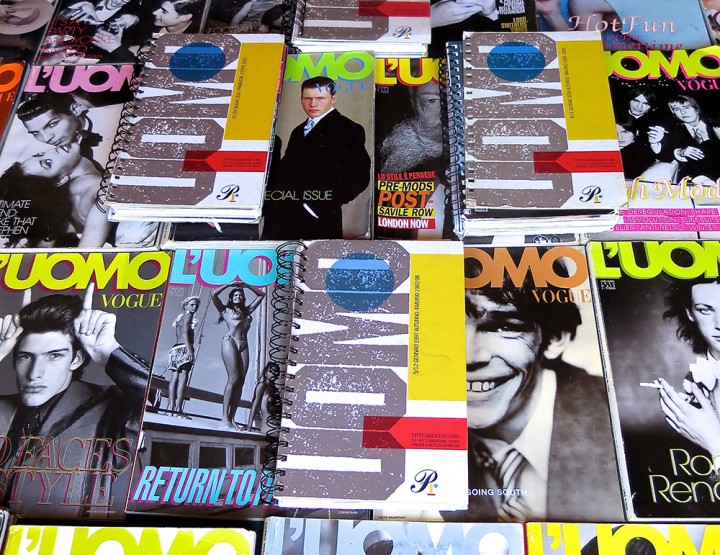AMAZING FAUSTO!
An inspired and intense portrait of the talented young Messina- born designer Fausto Puglisi, set to make fashion history.
“We shouldn’t take ourselves too seriously! As designers we are here to make rags, it’s the people out there saving lives who are the real heroes. We create beauty, our job is to allow you to dream”.
Messina, 11 o’clock, December the 24th 2013; with the indomitable courage of a kamikaze I rush into Muschio e Miele, the famous boutique on via Giordano Bruno, where I’m about to meet Fausto Puglisi, the most acclaimed young designer to emerge from the Italian fashion scene.
Wearing my giddiness, a smile and the perfect fashion-blogger outfit I greet him with bold nonchalance: “Hi Fausto, I really hope you like me!”
We shake hands, he kisses my cheek as if we’d know each other for ever and simply says: “How wonderful! Look at you! That skirt from my resort collection looks amazing on you…It really does!”His breezy and enthusiastic greeting instantly breaks down any formalities and I realize that, as ever, “emotion is what really counts” and that this is going to be a meeting exclusively about emotion. A couple of hours, several cigarettes and a coffee while we wait for his good friends Dino, Lina and Gisella Giuttari to join us – I have Fausto all to myself and I feel pretty damn lucky.
We talk about fashion, politics, beauty and about Made in Italy. But we also talk about Sicily, about Messina, his future and the young Messinesi, who he labels as outdated.
“I find them old” is a very strong statement! Many might feel offended, but I see his view on the young people of the city as his way of inviting them to become intrepid dreamers, because “a dream is a wish your heart makes” and wishes move our lives and push them beyond all limits; that’s where the concept of eternal youth lies.Fausto’s experience should be a source of inspiration for everybody, especially for the young people of our city.Il Sole 24 Ore has recently penned him as “Orgoglio Italiano” (Pride of Italy) and on my blog I have added “Orgoglio Messinese” (Pride of Messina).
As I observe him, his eyes flicker with a special kind of light, a spark, a flash of enthusiasm, passion, strength, achievement and beauty.
Sharp, straightforward, heroic, epic, seductive, free. Fausto’s Italian excellence is truly inspiring. As far as I can see there is no trace of snobbery or arrogance whatsoever in his manner, nor any wish to compromise. What I do see is a dignity that inspires admiration, which is thoroughly infective.
Born in 1976, he’d wanted to become like Armani or Versace ever since he was a child, he tells me. Having finished liceo classico, he packed a suitcase full of dreams and left Messina, heading for the United States. There he started working as coat check at Robert De Niro’s famous Tribeca Grill in New York.
The restaurant was a mecca for the international jet set and it was there that he met Patti Wilson, the world renowned stylist to the stars, who commissioned a dress for Whitney Houston.
Later, in California he met Arianne Phillips, stylist to Miss Ciccone and his fame among celebrities was established, with several major American department stores stocking his clothes. But not all that glitters is gold and just like any journey that leads to the realization of a dream, Fausto’s has been laden with obstacles, which he has singlehandedly managed to overcome with courage, great perseverance and heroic patience.
As St. Augustine once said “the force of desires makes endurance of labors and pains” and it was with this unwavering spirit etched in his heart, through disappointments and obstacles of all kinds, paradoxically experienced in Italy, that he finally got his big break.
In September of 2010, Domenico Dolce and Stefano Gabbana played host to his work at Concept Spiga Due, a space showcasing emerging fashion talents. From there, infinitely grateful for the opportunity given to him, his career took flight.
Anna Wintour, the almighty editor of American Vogue and undisputed empress of the fashion world, who has become popular with the wider public thanks to the film “The Devil wears Prada”, appreciates and celebrates him; Hollywood stars like Madonna and Katy Perry adore him.
The eccentric and exciting Anna Dello Russo, fashion editor and creative consultant of Vogue Japan has flooded the internet with her Fausto Puglisi outfits, becoming a source of inspiration for the fashion bloggers and addicts of the world.
In September 2012 the famous Florence concept store Luisa via Roma, dedicated the entire window display to pieces from his a/w 2013 collection, establishing his fame as cult designer of the season. In the meanwhile in Paris, he has taken the helm of Maison Ungaro, as the new creative director.
This April his creations will be exhibited at the Victoria and Albert Museum in London as part of the exhibition “The glamour of Italian Fashion 1945-2014” , he announces proudly,
as noble and proud as the gold lion in the cathedral steeple when it roars at midday, shaking Messina.
Fausto is truly eclectic and multifaceted, a living oxymoron.
His collections generate an incredibly strong magnetic field, their DNA steeped in history both ancient and personal.
Fausto embodies some of the most emblematic aspects of his native city Messina: the impetuous wind that blows across the Straits of Messina, continuously changing direction as it spins and twirls, mirrored by the strange phenomena of the whirling currents of the mythological Scilla and Charybdis, whose opposing currents perpetually meet and collide. The tales of this history are woven into his collections, their narratives an explosive mix of culture and counterculture, the Roman empire, Marie Antoinette, the Vara di Messina (a special religious procession honoring the Assumption of the Virgin Mary), the glamour of Hollywood, all coexist with riotous passion.
The sublimation of all these elements lends his pieces a pure aesthetic; geometric and sculptural qualities which hark back to the idea of an absolute beauty and of a sense of perfection, expressed most wonderfully by Greek sculpture.
I’d like to call his style Neo Classical-Pop Couture: an intriguing and fresh take on cosmopolitan modernity. In other words big news for the fashion world, which will undoubtedly cast new light on Made in Italy, long overdue for a big shakeup, and kindly provided by Fausto, whose blood pulses with the energy of an earthquake.
Thank you Fausto!
It was decided that we should meet at Muschio e Miele and I have a feeling there is a particular reason, isn’t there?
As a designer, I was literally born in this shop and I am extraordinarily fond of the Giuttari family.
My collection is being sold in a different boutique here in town owned by people with an incredible business flair and with whom I have a great commercial relationship, based on mutual respect… On the other hand, my connection to Muschio e Miele is a purely emotional one, rooted in the affection I feel for the Giuttari family who, along with my family, are the main reason I periodically travel back to Sicily.
We have an extraordinary bond and Lino and Gisella have both been important role models.
This is where my design aesthetic took shape; I owe them an awful lot.
I must have been about fifteen when I was struck by a wonderful Gianni Versace dress in the window while walking past the shop.
I have such a clear memory of that dress: it had an embroidered top and a crinoline with the word “Picasso”, paint…it looked like paint strokes…Amazing! I stood there for hours! I was dumbfounded by such beauty. A few days later I mustered up the courage to actually go in to the shop, which I had always considered a veritable temple. In an interview with British Vogue I recently said that I used to think of Muschio e Miele as a real treasure trove, an unapproachable Mecca, not because of the price tags but because of what it represented: “it was a sacred place! ”
There I met Gianni Versace, the man who has most informed my interpretation of fashion and Lina and Gisella, the two women who have strongly influenced my aesthetic.
I can recall every one of their outfits: from a purple ottoman dress worn by Gisella, with black safety-pinned ankle boots, to the red jacket with big gold and pearl buttons worn by Lina.
I started spending a lot of time at the shop and they patiently put up with this kid who never bought anything but often got in the way of crinolines and clients.
(“Fausto was so lovely, a real sweetheart” says Gisella!)
They were modernity, they were beyond anything else, it was the future and they represented Versace and his concept. Versace was the future! The only modern designer! The only contemporary designer who has expressed a truly modern vision of fashion!
How come you chose him as your mentor?
Because his work was a dream! His take on luxury was bold like a Ferrari! But at the same time Gianni was one of us, free of bourgeois illusions and utterly fearless.
What would you say to those who claim Fausto Puglisi imitates Versace?
Who’s saying what? Surely not the right people. I’m interested in what Anna Wintour, Suzy Menkes and Emanuelle Alt at Vogue Paris have to say…I’m interested in what the people who create fashion think, not those who envy me. The same Milanese conformists who used to call Gianni Versace “Copy-ace” back in the day are now, because of the generation gap, my mudslingers. When he opened his store in the heart of Milan, they said it looked like a graveyard but I think it was an outstanding accomplishment, a place of enchantment, a wonderful mausoleum. They despised his work and said he “dressed whores”!
Versace actually had a great fashion culture and many important points of reference: Chanel’s gold buttons, Paco Rabanne’s chainmail, Courrège’s bias-cut wool crêpe dresses! These were all designers who informed his work and whose work he took from and translated into his own style.
Recently asked by the editor of “Amica” Cristina Lucchini to come up with a title for a piece on Versace, I replied “Grazie Gianni” with great conviction.
I have always been very frank about Gianni being my source of inspiration. Every designer, just like any film director, photographer or artist, has one or more reference points.
A director might consider Pasolini or Antonioni as his masters, or maybe just as an inspiration.
In a memorable interview with Karl Lagerfeld, Gianni once said he was growing weary of people calling his creations vulgar. We could argue that a dress which is considered vulgar now might be considered iconic in twenty years time. There are so many people who look back at the unique world created by Versace with great fondness.
I think I find myself in a similar position now, although I am one of the designers Anna Wintour spoke about during the last press conference in Milan.
I am interested in appearing in American Vogue because Anna Wintour is one of the women who have built fashion as we know it. I’m also happy to discover that a journalist from “Le Figaro” sees something that reminds her of Elsa Schiapparelli’s designs from the 20’s in my work.
That same inspiration reclaimed by Dior and then handed down to Courrèges and Versace.
This is what I like to hear, but to say that I rip off Versace is foolish!
As far as sales are concerned I’m at the top of my game amongst new Italian designers.
All the leading figures on the international fashion scene were in the audience at my first show in Milan, and right now I’m the only emerging designer who has made it into the pages of American Vogue.
These are the people who shape the fashion landscape and who are interested in me, the rest can say whatever they like, I’m not listening.
Chanel once said “fashion changes, style endures”. What is your idea of style?
I find “style” such an empty word. It’s like “chic”, which I think must be the oldest word in the world. What counts is our own personal experience, our feelings, our tastes, our way of seeing and living.
Lina Giuttari IS style to me, wearing her black sunglasses at night and with her unique way of wearing jewelry. Style is our own irreplaceable individual uniqueness.
At the end of it all, what counts is what you are and what you do to be happy.
Speaking of style, you were appointed as creative director of Maison Ungaro in March, what do Fausto Puglisi and Emanuel Ungaro have in common?
It has already been an incredible experience and Ungaro totally matches my vision. He started his career at Balenciaga and Courrèges and has become famous for his unique take on baroque, opulence, color and femininity. I have studied his work in great depth and while keeping its essence, I have tried to give it a contemporary twist: some elements have been discarded, bows have become butterflies and ruches have turned into orchids and dragonflies.
The leopard-print dress with the gold butterflies is amazing. Katy Perry wore it to the VMA Awards as did Coco Rocha, albeit in its full-length version, on the 6th of May, when we went to the MET Gala.
You often use the expression “sexual being” when talking about the Puglisi woman. What is the difference between being sensual and sexual?
I hate the word “sensual”! You’re either sexy or you’re not. “Sensual” makes as much sense as “chic” does to me. You don’t need to bare your breasts or any other part of your body to be sexy. In fact you could be completely covered up and still be very sexy.
An expression can be sexy, great energy can be sexy. Sexual and sexy are not the same thing, as the Americans and the British have already come to understand before the rest of us. No one ever uses “sensual”! – people use the word “sexy”, which comes from “sex”. To be sexual means to have the power to create great desire, generate a strong feeling that packs a punch and pulls your insides out. I’m all for strong emotions not feeble desires and to be sexy or sexual is the ability to shake others to their core, in the same way as music, art, or the person you love do.
While building my aesthetic, what I look for is to create strong emotion, to inspire and create desire.
What are the elements that make up your aesthetic?
I’m interested in beauty and I have a very personal idea of what is beautiful. I can’t stand the idea of inner beauty/external beauty. As a designer, people call upon me to create an aesthetic, and aesthetics have nothing to do with ethics. I am also aware that there is an ethical beauty in the work of doctors, researchers and scientists, who strive to save human lives. This morning I came across some pictures of immigrants who had sewn their lips shut in protest, and was deeply moved. Their eyes were astonishingly beautiful and had absolutely nothing to do with muscles or fashion. There was such beauty in that desperation, a higher beauty, almost divine.
We share our dreams, we create aesthetics and aesthetics have to do with Helmut Newton’s pictures or Kate Moss, that is our only concern. We shouldn’t take ourselves too seriously! As designers we are here to make rags, it’s the people out there saving lives who are the real heroes. We create beauty, our job is to allow you to dream.
I don’t believe fashion should bear a social message and I hate it when fashion is exploited to address problems like anorexia and bulimia. Some people look at all the beautiful models and all they can come up with is that they are “clothes horses”; if only we could all be clothes horses, I say! I would also like to point out that to be thin is not necessarily symptomatic of malnutrition and bingeing but it is the sign of a healthy and balanced lifestyle.
Beauty is what it is and as much as I passionately uphold the Hellenistic ideal of beauty, the concept of “kalòs kagathòs” (the beauty of moral value) can’t really be applied to my work.
I can’t really be thinking about what is good AND what is beautiful when I’m designing, because I’d feel as if I’m fighting a losing battle. That part comes unconsciously.
Beauty feeds the soul and vice versa. The Italians have such beautiful souls because they are born and raised around beautiful things. If you exist around beauty then you naturally evolve into someone beautiful.
The Greeks were a beautiful people because they were so evolved and reached beauty with ease.
The spirit should feed on culture.
When designing, I concentrate solely on my ideal of beauty.
I recently discovered that Greek and Roman temples were multicolored and I got terribly excited imagining them that way. I feel that I would be totally overcome by that sense of giddiness, that punch in the stomach that only real beauty makes you feel… if I were to see a temple painted gold, red, orange and turquoise.
This is the reason I use a lot of gold, black and color blocking.
I think the worst thing for a designer is to think of sales when creating a collection; in most cases you won’t sell a single piece. I always set out to create what I feel, and what I know makes me happy, and that is usually the collection that works and sells best.
The future will decide whether I have created something beautiful, ugly, horrific, desirable, spiritual or even dreamlike with my work… I dream, Fausto, because you give us the power to do so!
AMAZING FAUSTO!
Ritratto intenso e appassionato di Fausto Puglisi giovane e talentuoso designer messinese che passerà alla storia della moda.
“Non prendiamoci troppo sul serio! Noi designer siamo qui a far stracci, i veri eroi sono coloro che salvano le vite umane. Noi costruiamo estetica e dobbiamo solo far sognare”.
Messina, 24 Dicembre 2013, ore 11, con l’indomito coraggio di una kamikaze mi lancio e varco la soglia di Muschio e Miele, la storica boutique di via Giordano Bruno, dove sto per incontrare Fausto Puglisi, il più acclamato giovane designer della moda italiana. Indossando solo le vertigini, un sorriso e un outfit da perfetta “fashion blogger”, lo saluto con spavalda incoscienza: “Ciao Fausto, spero tanto di piacerti!” Lui mi stringe la mano, e mi bacia sulla guancia, come se ci conoscessimo da sempre e senza nessun cerimoniale, mi dice: “Che meraviglia! Sei un’apparizione! La mia gonna della collezione resort ti sta benissimo… Davvero!” La leggerezza e l‘entusiasmo con cui mi accoglie smontano all’istante ogni formalità e intuisco che come sempre “è il cuore che conta” e che dunque questo incontro si baserà solo ed esclusivamente sul cuore. Così, per qualche ora, aspettando che arrivino i suoi cari amici, Dino, Lina e Gisella Giuttari, tra un caffè e qualche sigaretta, ho Fausto tutto per me e mi rendo conto di avere una fortuna sfacciata. Chiacchierando dei più disparati argomenti delineo lucidamente il suo profilo: di fronte a me ho un ragazzo molto, molto speciale. Parliamo di moda, di politica, di bellezza, di Made in Italy. Ma parliamo anche della Sicilia, di Messina, del suo futuro e dunque dei giovani messinesi che definisce vecchi. “Li trovo vecchi “, è un’affermazione forte! Forse, molti potrebbero sentirsi offesi, ma a ben guardare, penso che il suo sguardo sui giovani messinesi sia da interpretare piuttosto come un invito a diventare intrepidi sognatori, “perché i sogni son desideri” e i desideri muovono la vita e la spingono oltre ogni limite e in ciò risiede il concetto dell’ eterna giovinezza.E difatti, l’esperienza di Fausto Puglisi dovrebbe essere fonte d’ispirazione per tutti, soprattutto per i giovani della nostra città.Il Sole 24 Ore recentemente lo ha definito “Orgoglio Italiano”. Io ho aggiunto nel mio blog “Orgoglio Messinese”.Mentre lo guardo i suoi occhi sono attraversati da una luce particolare, una scintilla, una scossa che trasmette entusiasmo, passione, forza, realizzazione, bellezza.
Arguto, schietto, eroico, epico, seducente, libero, Fausto è un’eccellenza italiana che ispira. Nel suo modo di essere non scorgo alcuna traccia di snobismo o di arroganza, né tantomeno un’inclinazione al compromesso. Scorgo piuttosto una dignità che mi suscita ammirazione e mi contagia. Classe 1976, fin da piccolo, mi racconta, voleva diventare come Armani e Versace. Finito il liceo classico, prepara una valigia con dentro solo il suo sogno e lascia Messina diretto alla volta degli Stati Uniti. Comincia così a lavorare come guardarobiere in un famoso ristorante di New York, il Tribeca Grill di Robert De Niro. Il locale è frequentato dal jet set internazionale e lì conosce Patti Wilson, famosa stylist di molte Star, che gli commissiona un abito per Whitney Houston. Successivamente, in California, l’incontro con Arianne Phillips, la stylist di Miss Ciccone, determina la sua fama tra le Celeb ed i suoi abiti cominciano ad essere venduti in alcuni Department Stores americani. Ma non è tutto oro quel che luccica: così come ogni percorso che conduce alla realizzazione di un sogno, anche quello di Fausto è irto di ostacoli, superati solo grazie al coraggio con cui ha raccolto la sfida, alla grande tenacia e all’eroica pazienza. “La forza del desiderio rende tollerabili le fatiche e i dolori”, diceva Sant’Agostino, e con questo spirito indomito inciso nel cuore, tra insuccessi e impedimenti di ogni tipo, vissuti paradossalmente proprio in Italia, finalmente arriva la svolta. Nel settembre 2011 Domenico Dolce e Stefano Gabbana lo ospitano nel Concept Spiga Due, spazio dedicato ai nuovi talenti della moda e da lì, infinitamente grato per l’opportunità datagli, spicca il volo. Anne Wintour, l’onnipotente direttrice di Vogue America, imperatrice indiscussa del regno della moda, ormai famosa al più vasto pubblico anche per il film “Il Diavolo veste Prada”, lo celebra e lo stima; le Star di Hollywood, da Madonna a Kate Perry, lo adorano. L’eccentrica e travolgente fashion editor e creative consultant di Vogue Japan, Anna Dello Russo, fa girare in tutto il web i suoi outfit griffati Fausto Puglisi ispirando blogger e fashion addicted di mezzo mondo. Nel settembre 2012 lo storico Concept Store di Firenze, Luisa via Roma, gli dedica l’intera vetrina con i capi della collezione autunno inverno 2013, consacrandolo cult designer della stagione. Intanto Parigi gli consegna le chiavi della Maison Ungaro di cui diventa il nuovo direttore creativo. Il prossimo Aprile le sue creazioni saranno esposte al Victoria and Albert Museum di Londra, all’interno della mostra THE GLAMOUR OF ITALIAN FASHION 1945-2014; me lo annuncia fiero, orgoglioso e dorato come il leone del campanile della cattedrale quando ruggisce nel mezzogiorno messinese scuotendo la città. Eclettico e poliedrico, Fausto è un ossimoro vivente. Le sue creazioni creano un campo magnetico fortissimo, il loro DNA è carico di storia, una storia antica ma anche personalissima. La storia che scorre nelle vene di Fausto è quella raccontata dal vento che soffia impetuoso sullo Stretto di Messina e che volteggia cambiando direzione di continuo, depositaria di quegli strani fenomeni, gorghi e vortici vertiginosi, che si ripetono da tempo inenarrabile nelle acque dei mitologici Scilla e Cariddi, per l’incontro e lo scontro di opposte correnti. Il racconto di questa storia è nelle sue collezioni e la loro narrazione è un mix esplosivo di culture e controculture che s’intrecciano in maniera orgiastica, spaziando dall’Impero Romano a Maria Antonietta, dalla Vara di Messina al glamour Hollywoodiano. La sintesi di questi elementi dona ai suoi capi un’estetica pura, geometrica, scultorea, da cui emerge prorompente l’ideale assoluto di bellezza e senso della perfezione espresso, nel suo massimo splendore, da una statua greca. La definirei, la sua, una NeoClassic-PopCouture, una moda che crea un’inedita, intrigante e cosmopolita modernità. Una novità assoluta nel mondo della moda che fa riaccendere i riflettori su un Made in Italy da troppo tempo bisognoso di una scossa vigorosa e Fausto Puglisi che il terremoto lo ha nel sangue, adempie devoto alla sua missione.
Grazie Fausto
Nel concordare il nostro incontro mi è stato chiesto che si tenesse da Muschio e Miele. Ho intuito che ci fosse una ragione particolare, è così?
Come designer sono nato letteralmente in questo negozio e per l’intera famiglia Giuttari nutro un affetto straordinario.In città la mia collezione è in vendita in un’altra boutique e i proprietari sono imprenditori eccezionali che hanno creduto nel mio progetto e con i quali ho un rapporto commerciale di enorme stima e rispetto reciproco. Al contrario, il legame con Muschio e Miele è un legame puramente affettivo che ha le sue radici nell’amore che provo verso ciascuno dei componenti della famiglia Giuttari che insieme alla mia famiglia sono il motivo per cui periodicamente torno in Sicilia. Sono legato a loro in maniera straordinaria e Lina e Gisella sono per me un punto di riferimento.
Io mi sono formato qui nel loro negozio e devo tutto a loro. Avevo quindici anni e proprio passando davanti al negozio rimasi folgorato dallo strepitoso abito di Giannni Versace esposto in vetrina. Ho un ricordo nitido di quell’abito: aveva il top ricamato e una gonna con la crinolina sulla quale c’era scritto Picasso, pittura… Sembravano pennellate… Stupendo! Rimasi per un’ora ad ammirarlo! Ero scioccato da cosi tanta bellezza. Dopo due giorni ebbi il coraggio di entrare in quel negozio che per me, ragazzino, rappresentava un vero e proprio tempio. In un’intervista a Vogue British ho dichiarato che io vedevo Muschio e Miele come un forziere, un tempio inavvicinabile e non per il costo degli abiti ma piuttosto per quello che ai miei occhi rappresentava:“era una sacralità!” Qui nel negozio ho incontrato Gianni Versace, la persona che ha segnato il mio modo di intendere la moda, e due donne, Lina e Gisella, che hanno influenzato potentemente la mia estetica. Per me loro erano infatti ambasciatrici di un’estetica modernissima. Ricordo ogni loro outfit: da un abito di ottoman viola indossato da Gisella con tronchetti neri con le spille da balia, alla giacca rossa con grandi bottoni di metallo dorato e perle indossata da Lina.
Cominciai così a frequentare assiduamente il negozio e loro pazientemente sopportavano questo ragazzino che non comprava nulla ma che soggiornava tra crinoline e clienti.
(“Fausto era tenerissimo, un amore”, esclama Gisella commossa!) Loro per me erano la modernità, erano oltre era il futuro e rappresentavano Versace e il suo concetto. Versace è stato il futuro! L’unico stilista moderno! L’unico contemporaneo che ha espresso un concetto di moda davvero moderna!
Perchè lo hai scelto come maestro?
Perché mi faceva sognare! Il suo era un lusso spavaldo, come quello di una Ferrari! Ma al contempo Gianni era uno del popolo, non aveva la borghesia in testa e non aveva paura di niente.
Cosa risponderesti a chi dice che Fausto Puglisi copia Versace?
Chi lo dice? Sicuramente non le persone giuste. A me interessa cosa dice Anna Wintour, Suzy Menkes, Emanuelle Alt di Vogue Paris… A me interessa cosa pensa chi fa la moda, non le persone invidiose. Anche Gianni Versace, all’epoca, veniva chiamato Copiace. A Milano alcuni “benpensanti,” quelli che oggi per generazione diversa sono i miei detrattori, ai tempi erano i detrattori di Gianni e lo chiamavano Copiace. Quando aprì il suo Store nel cuore di Milano gli invidiosi dicevano somigliasse ad un cimitero e invece era un capolavoro, un posto incantato, un mausoleo stupendo. Disprezzavano il suo lavoro e urlavano “veste le puttane”!
Versace invece era coltissimo in fatto di moda e aveva come punti di riferimento Chanel, i bottoni dorati di Chanel! E poi Paco Rabanne e le sue maglie di metallo! Courrèges e i suoi abiti di sbieco in crèpe di lana! Questi erano i designer ai quali si ispirava e che poi traduceva in uno stile tutto suo. In occasione della pubblicazione di un articolo dedicato a Versace sulla rivista Amica, la direttrice Cristina Lucchini mi ha chiesto a quale titolo pensassi, io ho risposto con un convinto “Grazie Gianni”. Ho sempre detto con estrema franchezza che il mio punto di riferimento è stato ed è Gianni. Ogni designer, così come ogni regista, fotografo o artista, ha i suoi riferimenti. Un regista potrebbe avere come miti Pasolini o Antonioni, o meglio come maestri, o come suggestioni. In una storica intervista insieme a Karl Lagerfeld, Gianni dichiarava di non sopportare più taluni giudizi che definivano le sue creazioni volgari. Ma un abito che oggi è considerato volgare probabilmente tra venti anni sarà considerato il capostipite di quest’era. Quanti rimpiangono quel mondo creato da Versace e che nessuno è stato più in grado di rappresentare? Oggi mi trovo in una situazione analoga.Tuttavia io sono tra i designer di cui Anna Wintour ha parlato nell’ultima conferenza stampa di Milano. A me interessa apparire su Vogue America perchè Anne Wintour è una delle donne che hanno costruito la moda. A me fa piacere scoprire che una giornalista di Le Figaro rintracci nel mio lavoro qualcosa che le ricorda lo stile di Elsa Schiapparelli degli anni venti, quel particolare tipo di immaginario ripreso poi da Dior e tramandato a Courrèges e Versace. Questo è ciò che mi piace sentire ma dire che copio Versace è troppo da stupidi! In questo momento sono il numero uno nelle vendite tra i nuovi designer italiani. Al primo fashion show di Milano era presente tutto il gotha della moda internazionale e in questo momento sono l’unico designer emergente ad essere dentro la fortezza inespugnabile di Vogue America. Queste sono le persone che fanno la moda e parlano di me, il resto può dire ciò che vuole perchè non mi interessa.
Chanel diceva la moda passa lo stile rimane. Cos’è lo stile per Fausto Puglisi?
Per me stile è una parola vuota, così come lo è la parola chic che trovo sia la parola più vecchia del mondo. Ciò che conta è l’esperienza personale di ciascuno di noi, le nostre sensazioni, il nostro gusto, il nostro modo di vedere e percepire la vita. Per me lo stile è Lina Giuttari con i suoi occhiali da sole neri che indossa anche la sera, i suoi gioielli e il suo modo unico di portarli. Lo stile è la propria unicità che non può ripetersi. Alla fine quel che conta è quello che tu sei e ciò che fai per essere felice.
A proposito di stile, da marzo scorso sei il nuovo direttore creativo della Maison Ungaro. Cosa hanno in comune Fausto Puglisi ed Emanuel Ungaro?
E’ un’esperienza straordinaria e Ungaro corrisponde totalmente al mio mondo. Ungaro ha cominciato la sua carriera da Balenciaga e Courrèges e, nelle sue creazioni, il barocco, l’opulenza, il colore, la femminilità sono il tratto distintivo. Ho studiato approfonditamente il lavoro di Emanuel Ungaro e, mantenendone l’essenza, ho voluto renderlo contemporaneo, così, ho eliminato alcuni elementi, i fiocchi li ho trasformati in farfalle e le ruches in orchidee e libellule. L’abito maculato con le farfalle d’oro è strepitoso. Lo ha indossato Katy Perry ai VMA Awards e Coco Rocha, nella versione lunga, il 6 maggio scorso sfilando con me sul red carpet del MET Gala.
Spesso quando parli della donna Puglisi utilizzi l’espressione essere sessuale. Che differenza c’è tra essere sensuale ed essere sessuale?
Infatti odio la parola sensuale! O sei sexy o non sei sexy. Sensuale è come chic, non ha senso. Essere sexy non vuol dire tirare fuori il seno o altre parti del corpo, puoi essere completamente coperta ed essere molto sexy. Uno sguardo può essere sexy, una grande energia può essere sexy. Sessuale e sexy sono la stessa cosa, gli americani sono avanti, gli inglesi anche ed hanno studiato questa parola. Sensual non si usa mai! Si usa invece sexy e sexy viene da sex che vuol dire sesso. Essere sessuale significa far nascere un desiderio fortissimo, suscitare una sensazione strong, un pugno nello stomaco, un qualcosa che ti prende le budella e te le tira fuori. Io amo le emozioni forti e non le emozioni deboli ed essere sexy o essere sessuali è un’emozione che ti scuote, come quella provocata dalla musica, dall’arte o dalla persona di cui ti innamori. Nel costruire la mia estetica, il fine che mi prefiggo è suscitare un’emozione forte, fare sognare, creare desiderio.
Da quali altri elementi è costruita l’estetica di Fausto Puglisi?
A me interessa la bellezza ed ho un’idea di bellezza molto personale. Odio i concetti di bello dentro, bello fuori. Io come designer sono chiamato a creare estetica e per me l’estetica non ha a che fare con l’etica. Poi scorgo una bellezza che ha che fare con l’etica e la lego alla bellezza dei medici, dei ricercatori, degli scienziati, che con il loro lavoro si preoccupano di salvare le vite umane. Stamane ho visto le immagini degli immigrati che in segno di protesta si sono cuciti la bocca e mi sono commosso. I loro occhi erano di una bellezza strabiliante e non rimandavano nè ai muscoli nè alla moda; esprimevano solo disperazione ed era una bellezza aulica, divina. Noi regaliamo sogni, creiamo estetica e l’estetica ha a che fare con le foto di Helmut Newton, Kate Moss e non stiamo a preoccuparci di altro. Non prendiamoci troppo sul serio! Noi designer siamo qui a far stracci, i veri eroi sono coloro che salvano le vite umane. Noi costruiamo estetica e dobbiamo solo far sognare. Non credo che la moda sia portatrice di un messaggio sociale. Odio che la moda venga strumentalizzata come ad esempio tutto quel gran parlare di anoressia e bulimia. Alcuni vedono modelle bellissime e quello che riescono a dire è solo che somigliano a delle “grucce” ed io penso allora “fossimo tutti grucce a quel modo!” Vorrei anche aggiungere che la magrezza non è data solo dal mangiare e vomitare ma da uno stile di vita sano ed equilibrato che rende sicuramente più belli. La bellezza è la bellezza e, per quanto io sia un appassionato sostenitore dell’ideale di bellezza ellenica il concetto “kalòs kagathòs” non credo di poterlo applicare al mio lavoro di designer. Nell’atto creativo non posso pensare di perseguire sia il bello che il buono perché mi sentirei perdente fin dall’inizio. Il bello e il buono lo crei senza saperlo e senza volerlo. La bellezza arricchisce lo spirito e viceversa. Noi italiani siamo così belli anche di spirito perchè siamo stati cresciuti e allevati tra le cose belle. Se vivi vicino alla bellezza, ti evolvi e diventi bello naturalmente. I greci erano belli perché erano un popolo evoluto e nell’evoluzione hanno raggiunto la bellezza con più facilità. Lo spirito deve nutrirsi di cultura. Quando creo mi concentro sul mio ideale di bellezza. Ho scoperto che i templi greci e anche quelli romani erano multicolor e immaginarli così mi emoziona moltissimo. Penso che se dovessi scorgere di fronte a me un tempio d’oro, rosso, arancione, turchese, verrei sopraffatto da quel senso di vertigine, da quel pugno nello stomaco che solo la bellezza ti fa sentire. Per questo motivo uso tantissimo oro, nero assoluto e colorblocking. Io trovo che la cosa peggiore per un designer è pensare di fare una collezione con l’obiettivo di venderla, in questo caso è certo che non vendi nulla. Al contrario, io parto sempre dall’idea di fare ciò che sento e che mi rende felice e quella sarà la collezione che riuscirà meglio e venderà di più. Alla fine sarà il futuro a decidere se con il mio lavoro avrò creato bellezza, bruttezza, orrore, desiderio, spirito, sogno…Sogno, perchè Fausto, ci fai sognare!
ME AND FAUSTO
MY OUTFIT
SHOP WINDOW OF LUISA VIA ROMA
ANNA DELLO RUSSO
UNGARO PRECIOUS DETAIL
COLLECTION SS 2014
PRE SS 2014
THANKS TO


